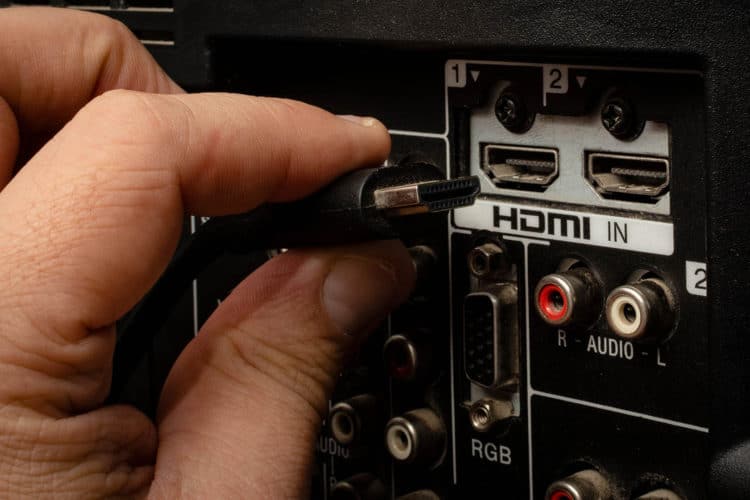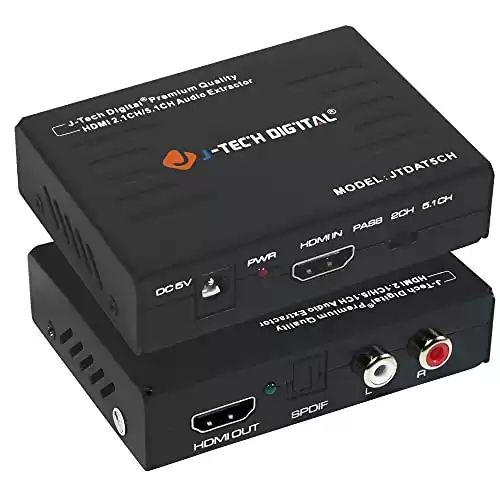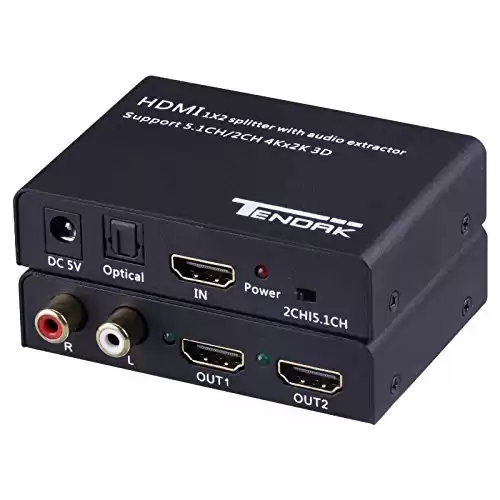If you want to separate HDMI audio from video, the fastest way to get the job done is to use a splitter. With this device, you can plug the cable in from the source material to distribute it through the product to the appropriate output.
This option works well when you want to route the picture to an HDTV and the sound to an audio resource, such as a soundbar.
Although you could use Bluetooth and your ARC to produce a similar result, there is one advantage that makes a splitter worth considering. You won’t run into any interference issues since the signals route through cabling.
Most people can successfully split their HDMI signal for $50 or less. What matters more is the equipment quality used for an entertainment system.
How Do I Separate HDMI Audio from Video?
The only way to split audio from video on an HDMI signal is to route the transmission through a compatible splitter. If you already have amplified the audio, you can use a wireless HDMI kit or an AV receiver to reduce your sound system’s number of input points.
You can find an HDMI splitter below that gets the job finished by default. The other option is to transmit the HDMI signal wireless across a limited space to another display or sound system, but the price can be high for some setups.
The primary reason why you’d want to split the audio signal away from the video with an HDMI cable is that the speaker system in use doesn’t meet your needs. This issue often applies to TVs or projectors that have limited internal components.
When selecting the appropriate splitter for your needs, it’s essential to work with an item that supports the highest video resolution, which is 1080P.
It should also support 2.25 Gbps/225 MHz per channel with its bandwidth. If the unit supports uncompressed audio, such as LPCM, along with Dolby Digital options, you’ll typically get the results you want for your entertainment setup.
■ What Is the Difference between an Extractor and a Splitter?
Using an HDMI splitter for the A/V transmission allows for a dual HDTV or monitor setup. The signal sent contains both feeds, but those receiving it will only recognize the ones it can use.
If you have an HDMI extractor with your setup, it’ll use one input and another output to extract the audio signal only from the twin broadcasts of a regular HDMI cable.
That process allows it to get sent to the coaxial cables or other components through the audio or stereo output.
■ Are There Similarities between Extractors and Splitters?
You cannot plug a TV into the HDMI input for an extractor because those ports only receive signals – they don’t send them. That’s also the case when using a splitter input since it’s only separating the signal sent from a high-definition source device to different outputs.
In most cases, an extractor tends to be cheaper than a splitter since it allows for audio extraction. You can’t use it for a dual-monitor setup unless the second television functions more like a radio receiver.
It’s technically possible to do that routing, but it isn’t very practical.
■ What Should I Look for with an Extractor Splitter?
Instead of buying an HDMI splitter or an extractor, you can buy a hybrid device that delivers both functions in one connection. That makes it easier to stay within your budget while dealing with the issues of making the device-to-display connection work.
Some products offer several features or perks that enhance your entertainment experiences, such as stereo connections that work with legacy systems while supporting Dolby TrueHD and other choices.
The benefit of using this option is that you can take one HDMI input signal, such as one from a video game console, and send it to two HDMI output signal displays. You’ll receive the same output on both screens.
Simultaneously, you can extract the audio to route to a soundbar, sound system hub, or another similar resource.
■ What about Using a Split and Extract Solution?
Some people might need to use an audio extractor and splitter that can take the 2 or 5.1 CH audio from an HDMI source.
It’ll deliver the hi-fi audio solution that your receiver needs when it lacks a true HDMI output, and your electronics only have an output option for you to use.
This option is something to consider when you play on a PS3 or PS4, Xbox systems, Fire TV, Nintendo Switch, and most cable or satellite boxes.
■ Should I Buy an HDMI Adapter?
An HDMI adapter is the simplest and cheapest way to split the audio from a signal. It’s also the least likely to work in the way that you need.
This product works well when connecting an HDMI signal to a DisplayPort 1.2 connection or an ethernet port. It provides extension resources only because they’re essentially the same.
You still need to purchase a converter or an extractor when handling a non-HDMI source or a legacy audio system.
Optical cables with coax connections or an RCA analog setup are the two options that face this issue consistently.
■ Where Can I Find an Affordable A/V Receiver?
Since theater-quality A/V receivers are typically priced at $200 or more when sold at retail, it might be tempting to look for cheaper second-hand options online or in local stores. Although you might save some cash this way, you’re also losing any guarantees or warranties that come with new products.
Older receivers might not have compatibility with some modern systems, which means it’s probably better to avoid eBay or Craigslist unless you have a specific idea of what your entertainment system requirements are right now.
What Are the Limitations of the Typical Splitter or Extractor?
Although splitters and extractors are a cost-effective way to route HDMI audio and video to separate locations, this technology comes with a few limitations that could impact your overall experience. The outcomes depend on your sound system setup, the general viewing location, cable length, and additional variables.
- It may be unable to support specific Dolby options, even though it might handle DT or 5.1 Dolby Digital fine.
- There might not be support for HDMI ARC as it prioritizes extraction over fidelity unless you choose an option that does both.
- Splitters don’t work well when the transmission isn’t HDCP compliant because there might not be any output received. It’s an anti-piracy safeguard, potentially activating the fallback mode with degraded resolution.
An HDMI converter is an option for some since it’s essentially the same as an audio extractor, but it’s more focused on converting the audio output into something different.
That means you’ll face more degradation for the sake of allowing the picture to play on a vintage TV set.
You’ll also need to be very careful when shopping for an HDMI audio splitting product. Many items use the terms interchangeably, so you might be getting a converter when you want to buy a splitter.
Read the reviews and the product description in its entirety, including the item’s specs, to ensure it meets your needs.
What Is the History of HDMI?
HDMI stands for “high-definition multimedia interface.” It’s a proprietary technology used for transmitting uncompressed video data and compressed or uncompressed digital audio data from a compliant source device.
With HDMI, you have a digital replacement for analog video standards.
The first production line of HDMI products reached consumers in 2003, although HDMI 1.0 was developed on April 16, 2002. This technology was found in HDTVs in 2004 and digital cameras in 2006.
Its creation is credited to several founders, including Sony, Toshiba, Thomson, Philips, Panasonic, Hitachi, and Silicon Image. HDCP was developed by Intel for this technology.
HDMI has the support of motion picture producers, satellite system operators, and cable television systems.
Between 2003 to 2023, approximately ten billion HDMI devices have been sold globally. Several versions have been developed and released over the years to improve A/V capacity, resolution, performance, and color spacing.
The latest update includes ethernet data connections, 3D elements, and CEC extensions.
HDM has three sets of general specifications based on its typing.
- Type A HDMI is 13.9 mm wide and 4.45 mm high.
- A Type B HDMI connection is 21.2 mm by 4.45 mm.
- With Type C HDMI, the connection is 10.42 mm by 2.42 mm.
- The Type D connections for HDMI are 6.4 mm by 2.8 mm.
- Type E HDMI is the automotive connection system. It has a locking tab that prevents the cable from vibrating loose while delivering an outer shell that provides water resistance.
That’s why it is essential to understand what splitting options are needed for your setup. If you have an older system, the connectors could be significantly different from what something newer requires.
Best Receiver to Use for a Home Theater Setup
My primary setup at home for movies, sports, and general viewing includes the Denon AVR-X1600H 4K UHD AV Receiver.
This equipment uses 80 watts per channel to deliver more operational stability than any other receiver I’ve ever used.
It can upscale HDMI sources, offers six inputs to use, and features a 4:4:4 pure color sub-sampling. The picture is incredible with HDR10, Dolby Vision, HLG, and much more.
Where it stands out the most is with its audio performance. Not only does it offer access to Dolby Atmos, but it also uses DTS:X and virtual options to create an incredibly immersive experience.
Although your room dynamics will play a direct role in the eventual acoustics received, this award-winning technology creates realism without seeming to try.
When I don’t feel like dealing with the entire setup, I can use the wireless streaming for Spotify, Pandora, and more.
It lets me play the same song in different rooms with its connection options, but I can also play different ones in each space with multi-room speakers. It’s one of the most flexible choices you can find today.
I can even access Siri, Alexa, or Google Assistant with its voice controls. That feature allows me to access my wireless music services effortlessly.
There have been some connectivity issues to balance with the Denon receiver. It’s a bit stubborn when working with Apple music.
You’ll also need front and rear high speakers to complete the Dolby Atmos experience. Without the extra support, the setup was only marginally better than my previous system.
Even with a few challenges, I’ve been exceptionally pleased with the results. It’s turned our weekly movie night into a positive experience for the entire family.
An Affordable Alternative for Your Entertainment Setup
HDMI audio splitters make sense when you can route cabling to the speakers in your setup. This option won’t work unless you split the source into the broadcasting mechanism if you have a wireless connection. Since that process degrades the sound quality received, it’s not a viable option for most homes.
If you don’t want to pay big bucks for a home theater setup, I recommend the following products to create a fun system to use.
- TCL 65-inch Television Class 6 Series with 8K Mini-LED
- TCL Alto R1 Roku TV Wireless 2.0 Channel Sound Bar
- Klipsch R-12SW Subwoofer
This combination delivers a robust sound that rattles the windows when I’m playing games on my PS5. It provides high-quality video with an excellent refresh rate while keeping the audio realistic.
It’s such a powerful combo that the vibrations can disconnect the cables when I have the volume above 50%!
Since you’re investing more in the television than the audio, you’re still reserving a setup for the future where a high-quality receiver could be helpful in the future.
Splitting the HDMI signal isn’t appropriate for every situation. If you need to route only the audio to a specific location, bookmark this guide to help you achieve that result.





